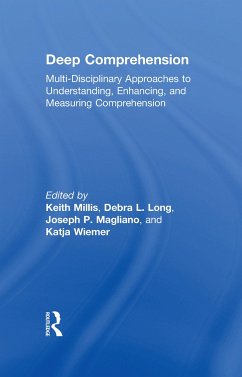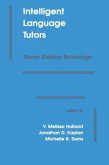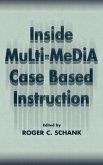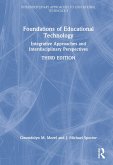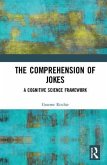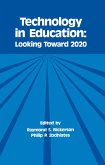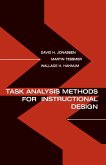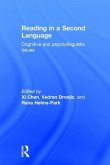Deep Comprehension
Multi-Disciplinary Approaches to Understanding, Enhancing, and Measuring Comprehension
Herausgeber: Millis, Keith K; Wiemer, Katja; Magliano, Joseph; Long, Debra
Deep Comprehension
Multi-Disciplinary Approaches to Understanding, Enhancing, and Measuring Comprehension
Herausgeber: Millis, Keith K; Wiemer, Katja; Magliano, Joseph; Long, Debra
- Gebundenes Buch
- Merkliste
- Auf die Merkliste
- Bewerten Bewerten
- Teilen
- Produkt teilen
- Produkterinnerung
- Produkterinnerung
This volume provides an overview of research from the learning sciences into understanding, enhancing, and measuring "deep comprehension" from a psychological, educational, and psychometric perspective.
Andere Kunden interessierten sich auch für
![Intelligent Language Tutors Intelligent Language Tutors]() Intelligent Language Tutors180,99 €
Intelligent Language Tutors180,99 €![Inside Multi-Media Case Based Instruction Inside Multi-Media Case Based Instruction]() Inside Multi-Media Case Based Instruction180,99 €
Inside Multi-Media Case Based Instruction180,99 €![Foundations of Educational Technology Foundations of Educational Technology]() Gwendolyn M MorelFoundations of Educational Technology161,99 €
Gwendolyn M MorelFoundations of Educational Technology161,99 €![The Comprehension of Jokes The Comprehension of Jokes]() Graeme RitchieThe Comprehension of Jokes181,99 €
Graeme RitchieThe Comprehension of Jokes181,99 €![Technology in Education Technology in Education]() Technology in Education181,99 €
Technology in Education181,99 €![Task Analysis Methods for Instructional Design Task Analysis Methods for Instructional Design]() David H JonassenTask Analysis Methods for Instructional Design181,99 €
David H JonassenTask Analysis Methods for Instructional Design181,99 €![Reading in a Second Language Reading in a Second Language]() Xi ChenReading in a Second Language220,99 €
Xi ChenReading in a Second Language220,99 €-
-
-
This volume provides an overview of research from the learning sciences into understanding, enhancing, and measuring "deep comprehension" from a psychological, educational, and psychometric perspective.
Hinweis: Dieser Artikel kann nur an eine deutsche Lieferadresse ausgeliefert werden.
Hinweis: Dieser Artikel kann nur an eine deutsche Lieferadresse ausgeliefert werden.
Produktdetails
- Produktdetails
- Verlag: Taylor & Francis
- Seitenzahl: 282
- Erscheinungstermin: 1. Oktober 2018
- Englisch
- Abmessung: 229mm x 152mm x 19mm
- Gewicht: 576g
- ISBN-13: 9781138089006
- ISBN-10: 1138089001
- Artikelnr.: 54337152
- Herstellerkennzeichnung
- Libri GmbH
- Europaallee 1
- 36244 Bad Hersfeld
- gpsr@libri.de
- Verlag: Taylor & Francis
- Seitenzahl: 282
- Erscheinungstermin: 1. Oktober 2018
- Englisch
- Abmessung: 229mm x 152mm x 19mm
- Gewicht: 576g
- ISBN-13: 9781138089006
- ISBN-10: 1138089001
- Artikelnr.: 54337152
- Herstellerkennzeichnung
- Libri GmbH
- Europaallee 1
- 36244 Bad Hersfeld
- gpsr@libri.de
Keith Millis is Professor of Psychology at Northern Illinois University and Deputy Director of the Center for the Interdisciplinary Study of Language and Literacy (CISLL). He studies comprehension and learning from text. Debra L. Long is Professor of Psychology at the University of California, Davis. She studies the knowledge and processes that are involved in text comprehension using behavioral, electrophysiological, and individual difference techniques. Joseph P. Magliano is Professor of Psychology at Northern Illinois University and Director of the Center for the Interdisciplinary Study of Language and Literacy (CISLL). He studies comprehension processes for text and film. Katja Wiemer is Professor of Psychology at Northern Illinois University and Co-Director of the Cognitive Science program. Her research focuses on abstract concepts, embodiment, and causal relations in scientific explanations.
Part 1: Understanding Deep Comprehension 1. Prose Comprehension Beyond the
Page Jennifer Wiley and Tricia A. Guerrero 2. Prose Comprehension Beyond
the Word Revisited Rolf A. Zwaan 3. A Memory Retrieval View of Text
Comprehension Debra L. Long and Erin M. Freed 4. Standards of Coherence in
Reading: Variations in Processing and Comprehension of Text Marja Oudega
and Paul van den Broek 5. What do We Think About When We Learn?Sidney K.
D'Mello 6. Reusing Neural Networks for Deep Comprehension Manuel de Vega
and David Beltran 7. What are We Reading for? A Disciplinary Literacy
Perspective on Purpose Susan R. Goldman and MariAnne George Part 2: Using
Technology to Increase Deep Comprehension 8. Learning Tasks in Electronic
Environments: Advances Towards Interactive eTextbooks Eduardo Vidal-Abarca
et al. 9. How can FACT Encourage Collaboration and Self-correction? Kurt
VanLehn et al. 10. Design Principles for Virtual Humans in Educational
Technology Environments Scotty D. Craig and Noah L. Schroeder 11.
AutoTutor: An Intelligent Tutoring System and its Authoring Tools Zhiqiang
Cai and Xiangen Hu 12. The Unreasonable Effectiveness of AutoTutor Andrew
M. Olney 13. Scaffolding Adult Learners' Reading Strategies in the
Intelligent Tutoring System Haiying Li and Whitney Baer 14. Learning
Scientific Inquiry from a Serious Game that Uses AutoTutor Keith Millis et
al. Part 3: Measuring Deep Comprehension 15. Using Scenario-based
Assessments to Measure Deep Learning Tenaha O'Reilly et al.16. Eliciting
Deeper Evidence through Conversation-Based Assessments Blair Lehman and G.
Tanner Jackson 17. NLP: Getting Computers to Understand Discourse Danielle
S. McNamara et al. 18. Deep and Shallow Natural Language Understanding for
Identifying Explanation Structure Peter Hastings, et al. 19. Deep
Comprehension of Text Revealed by Talking and Writing While Reading Joseph
P. Magliano, Karyn Higgs, and Keith Millis 20. Big Data for Thick
Description of Deep Learning David Williamson Shaffer
Page Jennifer Wiley and Tricia A. Guerrero 2. Prose Comprehension Beyond
the Word Revisited Rolf A. Zwaan 3. A Memory Retrieval View of Text
Comprehension Debra L. Long and Erin M. Freed 4. Standards of Coherence in
Reading: Variations in Processing and Comprehension of Text Marja Oudega
and Paul van den Broek 5. What do We Think About When We Learn?Sidney K.
D'Mello 6. Reusing Neural Networks for Deep Comprehension Manuel de Vega
and David Beltran 7. What are We Reading for? A Disciplinary Literacy
Perspective on Purpose Susan R. Goldman and MariAnne George Part 2: Using
Technology to Increase Deep Comprehension 8. Learning Tasks in Electronic
Environments: Advances Towards Interactive eTextbooks Eduardo Vidal-Abarca
et al. 9. How can FACT Encourage Collaboration and Self-correction? Kurt
VanLehn et al. 10. Design Principles for Virtual Humans in Educational
Technology Environments Scotty D. Craig and Noah L. Schroeder 11.
AutoTutor: An Intelligent Tutoring System and its Authoring Tools Zhiqiang
Cai and Xiangen Hu 12. The Unreasonable Effectiveness of AutoTutor Andrew
M. Olney 13. Scaffolding Adult Learners' Reading Strategies in the
Intelligent Tutoring System Haiying Li and Whitney Baer 14. Learning
Scientific Inquiry from a Serious Game that Uses AutoTutor Keith Millis et
al. Part 3: Measuring Deep Comprehension 15. Using Scenario-based
Assessments to Measure Deep Learning Tenaha O'Reilly et al.16. Eliciting
Deeper Evidence through Conversation-Based Assessments Blair Lehman and G.
Tanner Jackson 17. NLP: Getting Computers to Understand Discourse Danielle
S. McNamara et al. 18. Deep and Shallow Natural Language Understanding for
Identifying Explanation Structure Peter Hastings, et al. 19. Deep
Comprehension of Text Revealed by Talking and Writing While Reading Joseph
P. Magliano, Karyn Higgs, and Keith Millis 20. Big Data for Thick
Description of Deep Learning David Williamson Shaffer
Part 1: Understanding Deep Comprehension 1. Prose Comprehension Beyond the
Page Jennifer Wiley and Tricia A. Guerrero 2. Prose Comprehension Beyond
the Word Revisited Rolf A. Zwaan 3. A Memory Retrieval View of Text
Comprehension Debra L. Long and Erin M. Freed 4. Standards of Coherence in
Reading: Variations in Processing and Comprehension of Text Marja Oudega
and Paul van den Broek 5. What do We Think About When We Learn?Sidney K.
D'Mello 6. Reusing Neural Networks for Deep Comprehension Manuel de Vega
and David Beltran 7. What are We Reading for? A Disciplinary Literacy
Perspective on Purpose Susan R. Goldman and MariAnne George Part 2: Using
Technology to Increase Deep Comprehension 8. Learning Tasks in Electronic
Environments: Advances Towards Interactive eTextbooks Eduardo Vidal-Abarca
et al. 9. How can FACT Encourage Collaboration and Self-correction? Kurt
VanLehn et al. 10. Design Principles for Virtual Humans in Educational
Technology Environments Scotty D. Craig and Noah L. Schroeder 11.
AutoTutor: An Intelligent Tutoring System and its Authoring Tools Zhiqiang
Cai and Xiangen Hu 12. The Unreasonable Effectiveness of AutoTutor Andrew
M. Olney 13. Scaffolding Adult Learners' Reading Strategies in the
Intelligent Tutoring System Haiying Li and Whitney Baer 14. Learning
Scientific Inquiry from a Serious Game that Uses AutoTutor Keith Millis et
al. Part 3: Measuring Deep Comprehension 15. Using Scenario-based
Assessments to Measure Deep Learning Tenaha O'Reilly et al.16. Eliciting
Deeper Evidence through Conversation-Based Assessments Blair Lehman and G.
Tanner Jackson 17. NLP: Getting Computers to Understand Discourse Danielle
S. McNamara et al. 18. Deep and Shallow Natural Language Understanding for
Identifying Explanation Structure Peter Hastings, et al. 19. Deep
Comprehension of Text Revealed by Talking and Writing While Reading Joseph
P. Magliano, Karyn Higgs, and Keith Millis 20. Big Data for Thick
Description of Deep Learning David Williamson Shaffer
Page Jennifer Wiley and Tricia A. Guerrero 2. Prose Comprehension Beyond
the Word Revisited Rolf A. Zwaan 3. A Memory Retrieval View of Text
Comprehension Debra L. Long and Erin M. Freed 4. Standards of Coherence in
Reading: Variations in Processing and Comprehension of Text Marja Oudega
and Paul van den Broek 5. What do We Think About When We Learn?Sidney K.
D'Mello 6. Reusing Neural Networks for Deep Comprehension Manuel de Vega
and David Beltran 7. What are We Reading for? A Disciplinary Literacy
Perspective on Purpose Susan R. Goldman and MariAnne George Part 2: Using
Technology to Increase Deep Comprehension 8. Learning Tasks in Electronic
Environments: Advances Towards Interactive eTextbooks Eduardo Vidal-Abarca
et al. 9. How can FACT Encourage Collaboration and Self-correction? Kurt
VanLehn et al. 10. Design Principles for Virtual Humans in Educational
Technology Environments Scotty D. Craig and Noah L. Schroeder 11.
AutoTutor: An Intelligent Tutoring System and its Authoring Tools Zhiqiang
Cai and Xiangen Hu 12. The Unreasonable Effectiveness of AutoTutor Andrew
M. Olney 13. Scaffolding Adult Learners' Reading Strategies in the
Intelligent Tutoring System Haiying Li and Whitney Baer 14. Learning
Scientific Inquiry from a Serious Game that Uses AutoTutor Keith Millis et
al. Part 3: Measuring Deep Comprehension 15. Using Scenario-based
Assessments to Measure Deep Learning Tenaha O'Reilly et al.16. Eliciting
Deeper Evidence through Conversation-Based Assessments Blair Lehman and G.
Tanner Jackson 17. NLP: Getting Computers to Understand Discourse Danielle
S. McNamara et al. 18. Deep and Shallow Natural Language Understanding for
Identifying Explanation Structure Peter Hastings, et al. 19. Deep
Comprehension of Text Revealed by Talking and Writing While Reading Joseph
P. Magliano, Karyn Higgs, and Keith Millis 20. Big Data for Thick
Description of Deep Learning David Williamson Shaffer

